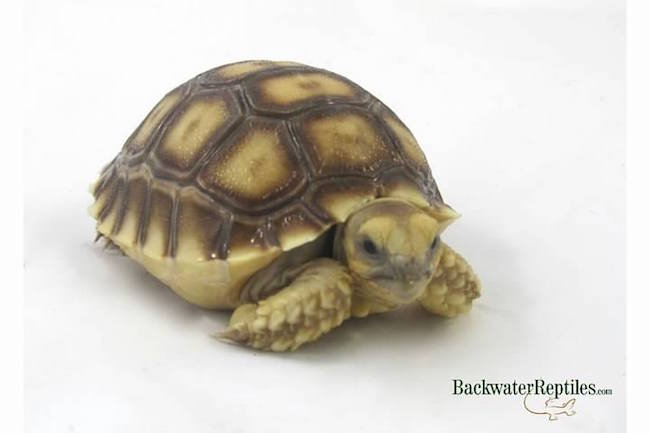Have you ever wondered which species of tortoise makes the best pet? Tortoises are big sellers here at Backwater Reptiles. They make excellent starter pet reptiles and many people like to get them for their children. They’re also fun for lots of people because they can live outside, are easy to feed, and have very long life spans.
This blog entry is going to focus on our top three most popular pet tortoises. We’ll discuss what makes each tortoise different from the others and provide care information so that potential new tortoise parents can make educated and informed decisions about which type of tortoise would be best for their household.

Sulcata Tortoise (Geochelone sulcata)
Number three on our list of the best pet tortoises is the Sulcata (aka the African Spurred Tortoise, the Spurred Tortoise, and the African Spur Thigh Tortoise), which is probably the tortoise species that is bred the most in the U.S. and thus the most readily available as far as captive bred hatchlings are concerned. This means that not only are they generally affordably priced, but also some of the healthiest due to the refined techniques of captive breeding. It is against the law to import Sulcatas into the U.S., so you know that every one available within the country is captive bred.

Like most tortoise species, Sulcatas can live outdoors. They get along with one another provided multiple adult males don’t occupy the same habitat (bullying can ensue if multiple males are kept together).
Keep in mind that Sulcatas can and will burrow, so make sure that your yard has a fenced perimeter both above ground and below ground if you want make sure your tortoise doesn’t go for a leisurely stroll outside your yard.
If you plan to utilize the outdoor tortoise enclosure method, it’s also best if you live in a climate that doesn’t experience harsh temperature extremes.
It’s estimated that Sulcatas live in the range of about seventy years. Hatchlings start off about one and half to two inches long and will grow into adults that weigh anywhere from seventy to 200 pounds (males).
Sulcatas are grazers and will eat grasses around your backyard. However, you should also be feeding them leafy green veggies and “salads” – the store bought grocery mixed greens that include kale, spinach, collards, etc. are great. Pre-made tortoise food is also a good supplement. No matter what, variety in the Sulcata’s diet is definitely a must.
Backwater Reptiles currently has captive bred Sulcata tortoise babies for sale.
Leopard Tortoise (Stigmochelys pardalis)
Number two on our list of the best pet tortoises is the Leopard Tortoise. This is the second largest African tortoise – only the African Spurred/Sulcata is larger. Adults measure anywhere from ten to eighteen inches in length, whereas hatchlings range from one and half to two inches long – just the perfect size to fit in the palm of your hand.

Outdoor housing is the preferred way to keep a Leopard Tortoise and these tortoises are not aggressive so males and females will coexist peacefully in a backyard where temperatures don’t get too hot or cold. These tortoises are not escape artists like their cousins the Sulcatas, however they still need a fence to keep them from roaming beyond the walls of your backyard.

Leopard tortoises have similar diets to other tortoise species with leafy green veggies high in calcium being their staple food. You can also supplement their diets with fruit, but in moderation.
Leopard tortoises are grazers like most tortoises and will therefore “mow your lawn” and consume grasses around their enclosure as well.
In addition to hide spaces, dirt for laying eggs, and basking areas, Leopard tortoises will require some type of standing water. They drink readily from water dishes so you might need to provide several depending on the size of their enclosure/yard. Always make sure their water is clean and fresh.
At the moment, we offer captive bred hatchling Leopard tortoises for sale.
Russian Tortoise (Testudo horsfieldii)
The number one best pet tortoise is, in our opinion, the Russian tortoise. Of the three species detailed in this blog, Russians are the smallest and toughest. When they hatch, they measure about an inch long and grow to be around eight to ten inches at most, making them very manageable.
These little tortoises will live around 40-50 years provided they have a good diet and stress free environment.
Russian tortoises are also best housed outdoors when possible and are notorious diggers. Fencing above and below ground is required to keep them from burrowing out of their enclosure and placing rocks in each corner of their home is also recommended to discourage escape digging.
A mild climate also helps with the digging issue as these tortoises will burrow when the weather is either too hot or too cold to shield themselves from the elements. In fact, Russian tortoises are used to living in a climate with temperatures that dip far below freezing (they dig burrows and stay underground during cold stretches).
If you are planning to keep your Russian tortoise outdoors, be sure all plants in the environment are non-toxic to tortoises as these guys prefer leaves and vegetation to grasses. Like the other tortoises in this blog, Russians will eat leafy green salad mixes from grocery stores and commercial tortoise food. Just make sure they have variety in their diet and they should readily eat most vegetation you provide.
At the moment, Backwater Reptiles has medium-sized Russian tortoises for sale. These animals are approximately four to five inches long.





